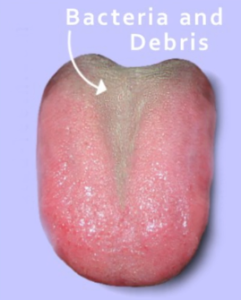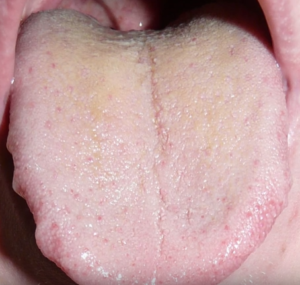Some of the common causes of green tongue along with the associated symptoms and treatment options are discussed below.
Causes of green tongue
Green tongue is usually a symptom of two types of oral cavity conditions, i.e., oral thrush and hairy tongue syndrome. Listed below are varied causes of green tongue:
-
Oral thrush or Oral Candidiasis
- Infection of the mouth by Candida albicans fungus/yeast is known as oral thrush. The infection is opportunistic and is prevalent in individuals with compromised immune systems. Use of ill-fitting substandard prostheses or dentures can also increase the risk of oral candidiasis, especially if the dental fixtures are used for a long period of time.
- In addition to green tongue, people with oral thrush may suffer from below mentioned signs and symptoms:
- The fungal infection of the tongue usually affects the top surface, but it can also affect other parts of tongue and the mouth.
- The tongue color may change from pinkish to white. Antibiotics use of eating food may cause the tongue to change color from whitish to green tongue.
- It is easy to scrape off the greenish coat on the tongue. Doing so will reveal a raw, throbbing, bleeding, and reddish part of the tongue
- Patients may also suffer from burning sensations in the oral cavity, bad breath, oral discomfort, and pain after intake of spicy or hot meals.
- Green tongue and its underlying causative oral thrush infection are treated in following ways:
- Anti-fungal ointments are used for treating the yeast infection
- Intake of adequate amounts of water and other fluids to remain hydrated
- Intake of a nutrition rich diet to boost the immune system and prevent future infections
-
Hairy Tongue Syndrome
- Hairy tongue does not mean that there is growth of actual hair on the tongue. It is however a common cause of green tongue.
- The top surface of a healthy tongue is velvety soft and smooth to see and touch. This texture is imparted to the tongue due to presence of filiform papillae, which are small projections or papillae
- The papillae on tongue along with the cells usually fall off or shed after their specific lifespan is over. However, in some cases, they do not shed at regular intervals but instead keep on growing. Such constant development of the papillae eventually makes them look like strands of hair. This is the reason for the name, i.e., hairy tongue syndrome.
- The now elongated papillae on the upper surface of tongue may get exposed to bacteria and other pathogens or contaminants. This can cause their color to change or get stained, resulting in green tongue. Sometimes, the hair-like structures and the completely tongue may become fully blackish.
- Doctors are not aware of the precise cause of hairy tongue condition. It is however believed that certain factors like excessive smoking, increased use of mouthwash, bad dental hygiene, and poor health of the oral cavity can increase the risk of hairy tongue syndrome and green tongue.
- In addition to green tongue, people with hairy tongue syndrome may suffer from below mentioned signs and symptoms:
- Metallic or sour taste in mouth
- Halitosis or smelly breath
- Increased risk of oral cavity infections
- Low-self esteem or other mental problems due to ugly tongue appearance
- Green tongue and its underlying causative hairy tongue syndrome are treated in following ways:
- Diagnosis of underlying causative factor, i.e., bacterial infection, etc., and then treating it
- Proper dental care and hygiene which includes daily brushing, flossing, use of mouthwash, etc.
- Quitting smoking
- Eating healthy balanced diet, exercising, and lifestyle changes.
Other causes of green tongue
- Green tongue may also occur due to below listed causes:
- Tongue piercings are at increased risk for infections and infected tongue may sometimes change color and become green. Tongue piercings may also pose problems in brushing, tongue cleaning, etc., thereby preventing or obstructing proper dental hygiene. Poor oral health increases susceptibility to tongue and mouth infections.
- If toothpaste or mouthwash has green dyes or greenish ingredients, then a temporary case of green tongue may occur.
- Short-term harmless instance of green tongue may also occur after sucking on green color candies
- Alcoholism, smoking, using varied tobacco products, and other items that damage mouth tissue can increase risk of infections and green tongue
- Sore throat or infection of upper airways may sometimes cause green tongue as a symptom
- Prolonged use of antibiotics, using illegal drugs, and smoking marijuana, etc., may also sometimes result in green tongue.


